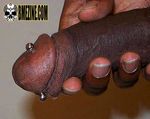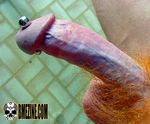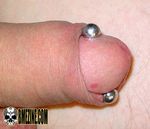Apadravya
An apadravya is a piercing passing top to bottom through the glans (although some men place it farther back, behind the glans, making it a "shaft apadravya"). It is essentially a PA and reverse PA combined, and in fact many apadravya piercees start with just the PA.
Contents |
Placement
The piercing is usually done on a slight to great forward slant; not only does this follow the lines of the body better (if you want to wear flat based jewelry, it needs to be pierced perpendicular to the point of entrance), it makes penetration (and withdrawal) simpler and can actually result in the jewelry taking on a wavelike movement as it's employed.
Procedure
The apadrayva can be performed using either a standard clamp-and-pierce method, a freehand method, or a scalpelling method. For any method, proper jewelry size should be determined pre-procedure by measuring the penis while erect. The piercer should keep in mind the angle and placement of the jewelry when taking these measurements. Many piercers will also take this measurement and add a small amount to ensure that the jewelry is not too short. For this piercing in particular it is much easier to deal with jewelry that has too much room over jewelry that is too short. Also, it should be noted that piercings through the male glans are possibly the most painful piercings for a male to receive. This is not a piercing to enter into lightly and the discomfort level should not be mistaken for that of a Prince Albert Piercing or Frenum Piercing.
Clamp-and-Pierce
After acquiring appropriately sized jewelry, the area should be cleaned and prepped. This typically involves the use of a surgical scrub or similar. It is also common during this piercing to clean the front side of the scrotum in addition to the glans in order to eliminate problems with subsequent contact between the penis and scrotum. A single-use marking instrument should then be used to mark the placement of the piercing. At this point, the head of the penis is lightly clamped and the needle goes through the head (top-to-bottom and bottom-to-top are both viable methods). After piercing the tissue, the clamps are removed and the jewelry is transferred into the piercing. It is common for this piercing to bleed (sometimes heavily) for several minutes after the piercing. Many piercers will ensure that the bleeding is controlled and proceed to bandage the piercing to prevent staining of pants. Because the glans of the penis is a high blood flow area this piercing may also bleed in small amounts for several days after the procedure.
Freehand Method
The only change between the Freehand Piercing method and the clamp-and-pierce method is during the piercing of the head. Instead of clamping the tissue it is held firmly and carefully in one hand and pierced with the other.
Scalpelling Method
Scalpelling methods are often employed when starting an apadravya at 4 gauge or larger. Scalpelled piercings, especially of this nature, should be left to a well qualified practitioner.
Healing and aftercare
The piercing usually takes four to six months to heal, however, a year or more is not uncommon. Additionally, an apadravya passing through the urethra tends to heal more quickly due to the constant cleaning from urination.
Long term health issues
The apadravya tends to be a very stable and comfortable piercing when done correctly. Due to the depth of the piercing and size of the jewelry, problems with migration are a seldom occurance. However, occasionally problems with prolonged bleeding occur due to intersection with the Corpus Cavernosum.
Urination can also be adversely affected by a trans-urethral apadravya. Sometimes this may cause the need to sit during urination but can often been managed by pulling the barbell upward to form a seal with the bottom portion of the piercing and allowing the "dribble" from the top to simply run off the top of the head. It is completely viable to urinate in a urinal via this method but many people find that sitting can be easier.
Many women agree that this is the most pleasurable piercing (in fact, this piercing is mentioned in ancient Indian love manuals, although some people disagree and say this is actually a reference to a sex toy). This is due to the basics of female anatomy: There's not a lot of point in creating pressure and sensation where it's not going to be appreciated, and the best piercing to massage most common female sweet spots is the apadravya. This should be remembered when considering an ampallang, as well as the "back teeth" factor. In addition, genital piercings should not be thought of as a magical cure for bad sex. Some women simply do not enjoy the feel of genital piercings. However, with proper jewelry sizing and experience with using the piercing, an apadrayva can often have a positive sexual effect.
Jewelery
Jewelry is almost always a straight barbell, pierced initially in 12 gauge or larger.
History and culture
The Apadravya piercing is mentioned in the Kama Sutra.
Alternative Names
- Happydravya
- because the apadravya piercing is said to be highly pleasurable for both the wearer and their partner, the nickname happydravya was coined to describe it. It is believed that this sources to a regular poster on rec.arts.bodyart from the mid 1990s, Chef.
Reference
<any materials cited in the article should go here. Web materials should be linked, textual materials should be properly cited, as in a bibliography.>
See also
External links
You can find lots of experiences about and pictures of apadravyas on BME.



